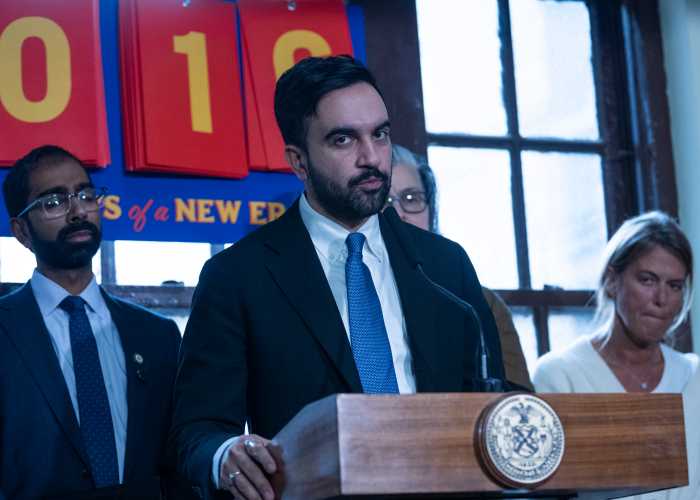By Janelle Nanos
For Al Torres, whose artwork is currently on display at the Art Gallery at the St. Cabrini Nursing Home in Dobbs Ferry, N.Y., this interaction is exactly what he's aiming for. When you see his paintings, it comes as no surprise that Al Torres has always looked at the world from many angles. His canvasses are built with accordion-like folds, with a different image painted on either side. As you walk from left to right, the images shift and merge, creating a third image which incorporates both an element of movement and the juxtaposition of ideas. “My art is a bit schizophrenic,” Torres admits. “There's always a double meaning.”Such dualities are common for Torres, a slight, dark-eyed Jackson Heights native who has been pursuing his passion for art since the age of 4. A struggling student in his early years at St. John's Prep, he found refuge in drawing, and eventually also found his way back into the classroom. For the past 13 years he's been an art teacher, and is currently working at IS 145 in Jackson Heights. It's an irony that doesn't quickly escape him. “I find that a lot of my kids aren't only challenged academically, but they're not prepared with life skills,” he says. “They need discipline, and if they can find it in another outlet, whether in sports or art, as long as there's something that they can get good at, they can transfer that discipline into other areas of their life.” Torres encourages his students to learn the basic elements of drawing, believing that they are the foundation of any great artist's work. He himself looks to the masters as his guides, claiming Michelangelo and the other great painters of that era were his teachers, and he emulated their work from an early age. “During the Renaissance, anyone who was an architect or painter or sculptor had to really be able to draw well,” Torres explained from the comfort of his cozy studio, which, like the Sistine Chapel, is also is decorated with graceful images which line the ceiling. “That was the basis of their art, and that's what it is for me.” And Torres himself is a bit of a Renaissance man. He trained as an architect at City College and spent several years with the Woolworth Corporation designing storefronts before realizing that he didn't like keeping within the “cookie-cutter parameters” that architecture involved. He now splits his time between teaching and painting, devoting about 20 hours a week to both, and he just recently completed his master's degree in fine arts at the New York Academy of Art.Although he's left it behind, you can still see Torres' architectural training in the construction of his canvasses. After sketching out the two separate images on drafting paper and determining how the images will intertwine, he then builds the folded canvasses from aluminum or wood. He will proceed to paint one entire image before moving on to the next. “It's painting half-blind,” he jokes.Torres started creating his “multi-view” paintings 15 years ago, inspired by the work of Israeli artist Yaacov Agam, whose multiview images of geometric figures undulate and appear to move as you walk alongside them. In contrast, Torres depicts living images in his multiview paintings, which often are seemingly incongruous until you begin to see them merge together. For example, one such painting depicts a view of the Earth from above when viewed from the left and an image of an unborn fetus from the right. When you look at painting from the front, you realize that both pictures tell a story of the creation of life. Like his Renaissance teachers, Torres also incorporates religious and spiritual themes in his art. A sampling of six multiview painting and 20 sketches are currently on display as part of a three-person exhibit “Artists 2005,” now showing at the Art Gallery at the St. Cabrini Nursing Home. “I thought it was very appropriate that his works had a spiritual theme, with this being Easter season,” said Joann Deydo, the art coordinator for the center, which is a Catholic institution. Deydo, herself an abstract painter, says she was drawn to Torres' unique style and his classical training. “He has images of the crucifixion, the origin, and Judas,” she says. “But they're different from the other things I've been showing.”For Torres, his art has always been about the viewer participation. Even his more spiritual works he sees as open to interpretation, enabling a viewer to create their own narrative for a scene. “I'm not trying to beat you over the head with my Christianity,” he says, and explains that in most of his images it's up to the viewer to decide what level of spirituality they care to decipher. “Art is finding your own way of putting down what you feel about the world.”




































